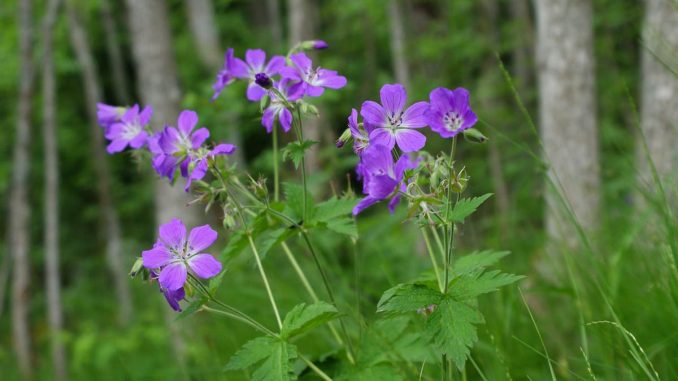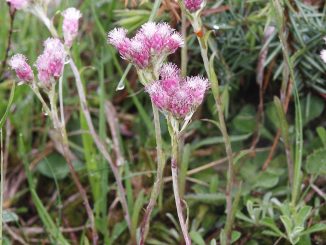
Contents
The robust wood cranesbill (Geranium sylvaticum) thrives in the garden on perennial beds as well as in flower boxes on the balcony. Equipped with natural charm and robust nature, it is a pretty wild perennial for shady areas.
Profile of wood cranesbill:
Scientific name: Geranium sylvaticum
Plant family: geranium family (Geraniaceae)
Other names: woodland geranium
Sowing time: spring
Planting time: spring
Flowering period: May and July
Location: semi-shaded to shady
Soil quality: loamy, fresh to moderately moist, lime tolerant, nutritious, humus rich
These information are for temperate climate!
Use in: flower beds, single position, group planting, under tress, overgrowth, flower garden, natural garden, forest garden
Winter hardiness: hardy, USDA Plant Hardiness Zones: 4 (-32 °C / -25 °F)
Bee and insect friendly: yes
Plant characteristics and classification of wood cranesbill
Origin and occurrence of wood cranesbill
The wood cranesbill is native to large parts of Europe to western Siberia. Its preferred locations include meadows and tall herbaceous vegetation as well as forest edges and bushes.
Plant order of wood cranesbill
The wood cranesbill (Geranium sylvaticum) is one of the numerous garden-worthy species of the genus Geranium. It belongs to the geranium family (Geraniaceae) and was cultivated in gardens as early as the 17th century.
Characteristics of wood cranesbill
Plant
With a growth height of between 40 and 60 cm (16 and 24 in), the wood cranesbill is one of the stately, cluster-like meadow perennials. Leaves and flower shoots grow from its thick rhizome into a loose growth pattern. As with almost all cranesbill plants, the above-ground parts of the plant are equipped with glandular hair that exudes an aerial fragrance when touched. In autumn, shoots and leaves die and Geranium sylvaticum survives the cold season with its persistent rhizome.
Leaves
The palmate leaves sit opposite to the shoots, have a strong green color and are pinnatifid lobes. The leaf tips are incised and the edge is sawn.
Blossoms
Between May and July, the wood cranesbill adorns itself with intensely colored, red-violet flowers that have a characteristic white center. The five-petaled, up to 3.5 cm (1.5 in) large flowers are usually in sets of two at the end of the flower stems.
Fruit
After pollination, the woodland geranium forms the fruits of cranesbill-like shape typical of the plant family. When the seeds mature, the capsules often open explosively and throw the seeds far out.
Wood cranesbill – cultivation and care
Location
The wood cranesbill prefers semi-shaded to shady places. If it is sufficiently cool and humid, you can plant it in a sunny location.
Soil
Soil rich in nutrients and humus is what Geranium sylvaticum likes best. The surface should always be fresh and well permeable.
Sowing
The wood cranesbill can be easily grown from seeds and also ensures its distribution at suitable locations by self-sowing. The clusters can also be multiplied very well by division, as well as mature shoot cuttings that are cut in summer. If you don’t want this, you can prune off the fruits.
Planting
The best time to plant is spring. When used over a large area, six plants of the woodland geranium are expected per square meter (10 square feet).

Division
The persistent wood cranesbill does not have to be regularly rejuvenated by division. However, if it spreads too much, you can dig out the cluster and divide it easily. The best time for this is spring.
Watering
Recently planted specimens of the woodland geranium should be watered regularly when it is dry to facilitate their growth.
Fertilization
A dose of compost in the spring boosts its growth.
Care
If you cut back the stems after the main flower close to the ground, Geranium sylvaticum develops a second bloom.
Diseases and pests
Like all cranesbills, Geranium sylvaticum is spared from snail feeding. The wild perennial has also proven itself to be robust and healthy.
Wintering
It is hardy, so no winter measures must be taken.
Use in the garden
Wood cranesbill is ideal for overgrowing in natural gardens and in open spaces. In sunny to half-shady perennial borders, it is a good partner for Canterbury bells, astilbe, goatsbeard and plantain lilies. There are also nice combinations with related cranesbill species such as the Himalayan cranesbill and Geranium gracile, both of which also love semi-shady and moist locations. Geranium sylvaticum copes well even in the shade of trees and bushes.




Leave a Reply